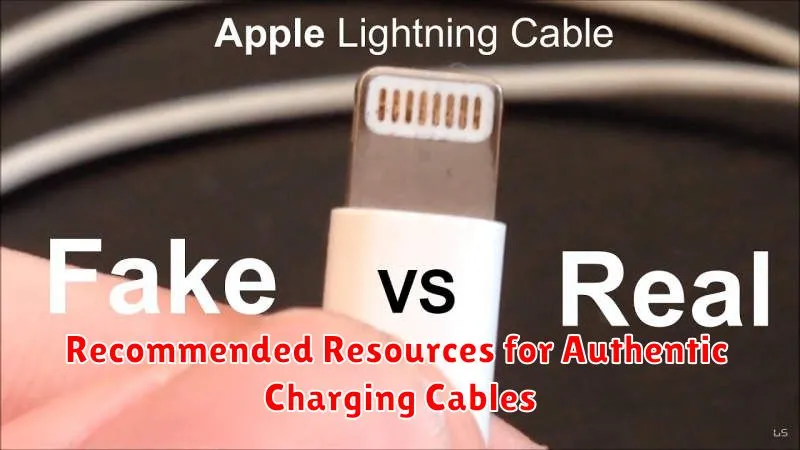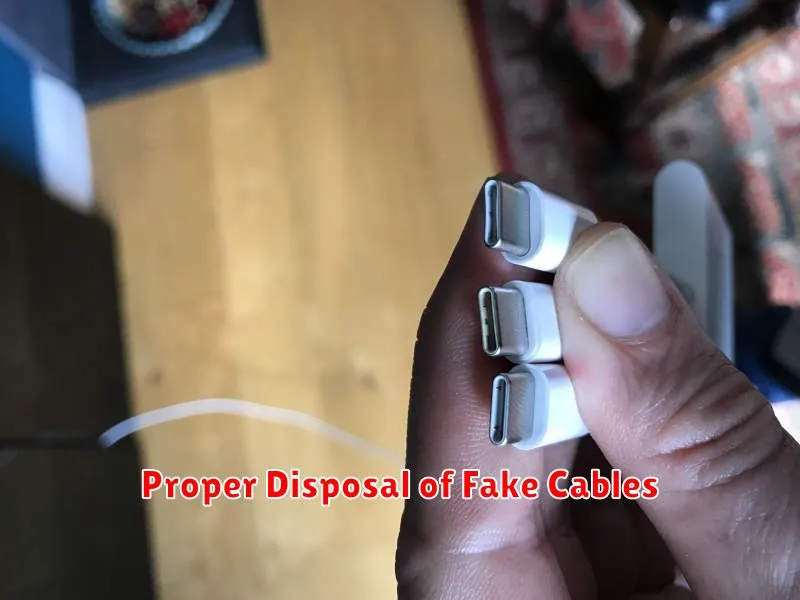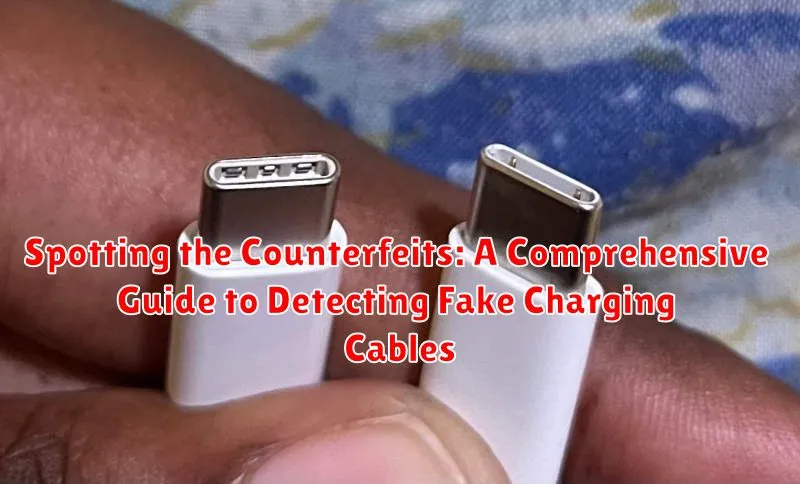Counterfeit charging cables pose a serious risk to both your devices and your safety. From smartphones and tablets to laptops and headphones, using a fake charging cable can lead to anything from slow charging and data loss to overheating, fire hazards, and even electrocution. This comprehensive guide, “Spotting the Counterfeits,” equips you with the essential knowledge to confidently detect fake charging cables and safeguard your valuable electronics. Learn how to identify telltale signs of counterfeit products, understand the potential dangers they present, and ultimately make informed purchasing decisions to protect yourself and your devices from the hazards of fake chargers and counterfeit cables.
Protecting yourself from the dangers of counterfeit charging cables starts with awareness. This guide delves into the critical distinctions between genuine and fake cables, providing practical tips and clear indicators to help you spot the counterfeits. We’ll explore the subtle nuances in packaging, cable construction, and markings that often betray a fake charger or fake USB cable. By understanding these key differences, you’ll gain the confidence to identify potentially harmful products and make safe, informed choices when purchasing charging cables for all your devices. Whether you’re concerned about fake Apple chargers, fake Android chargers, or other counterfeit cables, this guide offers invaluable information to protect your investment and ensure your safety.
Understanding the Risks of Fake Charging Cables
Using counterfeit charging cables poses significant risks to both your devices and your personal safety. These cheaply made imitations often cut corners on essential safety features, leading to a range of potential hazards.
Fire Hazard: Fake cables may utilize subpar materials and inadequate insulation, increasing the risk of overheating, short circuits, and potentially fire. This can damage your device and pose a serious threat to your home and well-being.
Device Damage: Counterfeit cables often deliver inconsistent or incorrect power levels. This can damage your device’s battery, circuitry, or even render it completely unusable. Replacing a damaged device is significantly more costly than investing in a genuine charging cable.
Data Loss: Some counterfeit cables are designed to steal data from your device during the charging process. This poses a severe security risk, potentially compromising sensitive personal information.
Slow or Inefficient Charging: Fake cables may not charge your devices efficiently, leading to prolonged charging times or even failing to charge them altogether. This can be frustrating and disruptive to your daily routine.
Visual Inspection: Identifying Counterfeit Cables
A careful visual inspection can often reveal telltale signs of a counterfeit charging cable. Examine the cable’s construction quality.
Look for poorly molded plastic, uneven seams, or flimsy connectors. Genuine cables typically exhibit a higher level of finish and attention to detail. Check the weight and flexibility of the cable.
Counterfeit cables often feel lighter and more flexible than their authentic counterparts due to the use of inferior materials. Pay close attention to the connector itself.
Examine the metal contacts for discoloration, rust, or misalignment. Compare the connector to an authentic cable, noting any discrepancies in shape, size, or markings.
Scrutinize the cable’s text and logos. Counterfeiters often make mistakes in font, spacing, or alignment. Look for blurry or misprinted text, and compare the logo to an authentic cable. Subtle differences can indicate a fake.
Performance Testing: Checking for Red Flags
Beyond visual cues, performance testing offers valuable insights into a charging cable’s authenticity. Slow charging is a primary indicator of a counterfeit cable. If your device charges significantly slower than usual with the cable in question, it warrants further scrutiny.
Overheating is another serious red flag. Counterfeit cables often utilize subpar materials and construction, leading to excessive heat generation during charging. This poses a safety risk to both your device and yourself. If the cable, the charging brick, or your device becomes unusually hot, discontinue use immediately.
Finally, inconsistent charging behavior can be indicative of a fake cable. This might manifest as intermittent charging, where the connection cuts in and out, or the device displaying a “Not Charging” message even when plugged in.
Brand Verification and Packaging Scrutiny
Brand verification plays a crucial role in identifying counterfeit charging cables. Carefully examine the cable and its packaging for the manufacturer’s logo and branding. Check the manufacturer’s official website for images of genuine products and compare them to the cable you are inspecting. Look for inconsistencies in font, logo size, or color, which are common indicators of counterfeit goods.
Packaging scrutiny can also reveal valuable clues. Genuine products typically come in high-quality packaging with clear printing and accurate product information. Counterfeit cables often have blurry printing, misspelled words, or grammatical errors on the packaging. Pay close attention to the details. Is the packaging material flimsy or does it feel substantial? Does the packaging accurately describe the cable’s specifications and compatibility? These small details can help differentiate authentic products from counterfeits.
USB Certification and Safety Standards
Genuine charging cables adhere to strict USB certification standards. These standards ensure compatibility and, more importantly, safety. Counterfeit cables often bypass these certifications, posing significant risks.
Look for the USB logo on the cable and packaging. While not foolproof, its presence suggests some level of compliance. Certified cables undergo rigorous testing for power delivery, data transfer speeds, and overall build quality. This testing minimizes the risk of overheating, short circuits, and damage to your device.
Safety certifications, such as UL or CE markings, are crucial indicators. These markings signify that the cable has met specific safety requirements. Counterfeit cables rarely carry legitimate safety certifications, putting your devices and even your safety at risk.
Comparing Prices and Seller Reputation
One of the most effective ways to avoid counterfeit charging cables is to carefully consider the price and the seller’s reputation. Unrealistic prices are a major red flag. If a cable is being offered at a significantly lower price than the average market value, it’s highly likely to be a counterfeit.
Thoroughly research the seller. Check their reviews and ratings on reputable platforms. Look for established sellers with a history of positive customer feedback. Be wary of new sellers or those with predominantly negative reviews. A seller’s reputation can be a strong indicator of the authenticity of their products.
Compare prices across multiple vendors. This will give you a good understanding of the average market price for the specific cable you are looking for. Any substantial deviations from this average should be treated with suspicion. Be particularly cautious of deals that seem too good to be true.
Protecting Yourself from Counterfeit Cable Scams
Be wary of unbelievably low prices. If a deal seems too good to be true, it probably is. Counterfeit cables are often sold at significantly lower prices than genuine ones to lure unsuspecting buyers.
Purchase from reputable sources. Buy your charging cables directly from the manufacturer or from authorized retailers. Avoid purchasing from unfamiliar third-party sellers, especially on online marketplaces.
Inspect the packaging carefully. Authentic charging cables typically come in high-quality packaging with clear branding and product information. Look for inconsistencies like misspellings, blurry images, or low-quality printing, which can indicate a counterfeit product.
Check for certification markings. Genuine cables often have certifications like MFi (Made for iPhone/iPad/iPod) or USB-IF certification. Counterfeit cables may have fake or missing certification logos.
Report suspicious sellers. If you encounter a seller you suspect is selling counterfeit cables, report them to the platform or marketplace where you found them. This helps protect other consumers from falling victim to the same scam.
Recommended Resources for Authentic Charging Cables

Sourcing authentic charging cables is crucial for device safety and optimal performance. Purchasing directly from the manufacturer is always the safest bet. This guarantees a genuine product and often comes with warranties.
If buying from a third-party retailer, choose authorized retailers. These vendors have established relationships with manufacturers and are more likely to sell genuine products. Look for official certifications or designations on retailer websites that indicate authorized partnerships.
Consider purchasing certified cables. Look for certifications like “Made for [Device Brand]” (e.g., “Made for iPhone”). These certifications indicate that the cable has met the manufacturer’s quality and compatibility standards.
Proper Disposal of Fake Cables

Improperly discarding counterfeit charging cables can contribute to environmental harm and potential safety hazards. Do not simply throw fake cables in the trash.
E-waste Recycling: The best way to dispose of counterfeit cables is through designated e-waste recycling programs. Many municipalities offer specific collection points or events for electronic waste. Check with your local government for resources.
Retailer Take-Back Programs: Some electronics retailers offer take-back programs for electronic accessories, including cables. Inquire with retailers in your area to see if they accept counterfeit cables for recycling.
Hazardous Waste Considerations: If the cable shows signs of damage, such as frayed wires or exposed metal, it’s best to treat it as potentially hazardous waste. Contact your local waste management authority for guidance on safe disposal procedures for hazardous electronic waste.

